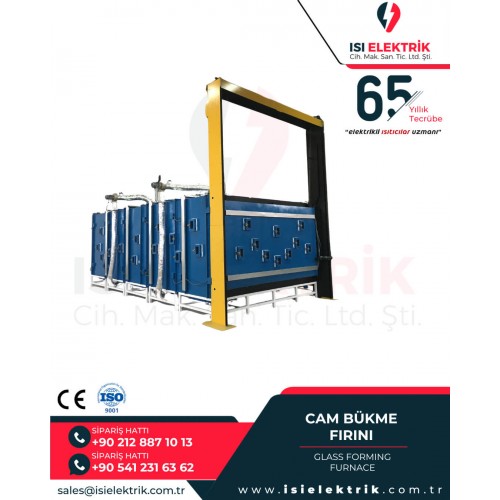Glass Bending Furnace Heaters
Glass bending furnace heaters are essential components used to provide heat in furnaces utilized for glass shaping processes. These furnaces are typically employed for softening, stretching, and shaping glass.Glass bending furnaces usually feature a specially designed structure housing one or more heaters. These heaters receive electrical current and generate heat to attain the desired temperature for the glass.Applications of Glass Bending Furnace Heaters
The applications of glass bending furnace heaters may include:- Production Processes: In the glass industry, there are various production processes for shaping and processing glass sheets. Glass bending furnace heaters can be used to ensure temperature control in these processes. For example, heaters play an important role in processes such as bending glass sheets and producing curved glass.
- Specialized Glass Products: Specialized glass products may be required for certain industrial and commercial applications. Glass bending furnace heaters can be used in the production of these special glass products. The use of glass bending furnaces and heaters is common in the production of special glass materials for automotive, furniture, or architectural purposes.
- Research and Development: Research and development efforts are undertaken to develop new technologies and products in the glass industry. Glass bending furnace heaters can be used for temperature control and shaping of glass materials in such research and development activities.
- Artistic and Decorative Applications: Glass art and decorative glass products are produced by bending and shaping glass sheets. Glass bending furnaces and heaters can be used by artists and designers to bend glass in desired shapes and patterns.
Advantages of Glass Bending Furnace Heaters
The advantages of glass bending furnace heaters include:- Reduced Waste Production: Heaters can help reduce waste production during the glass bending process. Precise temperature control ensures that glass sheets take the desired shape, resulting in less waste in marked dimensions.
- High Production Capacity: Glass bending furnace heaters can have high production capacity due to their fast heating properties. This allows businesses producing glass products to process more products in a shorter time.
- Quality Control: Heaters enhance quality control during the glass bending process. With precise temperature and time settings, the quality of produced glass products can be more consistent, ensuring compliance with standards.
- Longevity: Quality heaters can have a long lifespan. This reduces maintenance costs for businesses and ensures uninterrupted production processes.
- Less Thermal Stress: Heaters providing homogeneous heat distribution ensure that glass sheets experience less thermal stress during the bending process. This can increase product durability and improve quality.
Technical Specifications of Glass Bending Furnace Heaters
- Power: The power of the heater is measured in watts (W) and determines the heating capacity. As power increases, glass heats up faster and bends more easily.
- Voltage: The operating voltage of the heater is measured in volts (V) and determines its compatibility with the electrical grid. Commonly used voltages are 220V and 380V.
- Current: The operating current of the heater is measured in amperes (A) and determines the electricity consumption. As current increases, the heater consumes more electricity.
- Resistance: The resistance of the heater is measured in ohms (Ω) and determines its resistance to electrical current. As resistance increases, the heater consumes less electricity.
- Temperature: The maximum temperature the heater can reach is measured in degrees Celsius (°C). Heater with different temperature values is preferred depending on the type of glass used.
- Heat Distribution: How the heater distributes heat to the glass is important. Homogeneous heat distribution ensures flawless and uniform bending of glass.
- Type: Different types of heaters are used in glass bending furnaces:
- Air Heaters: Heat air to indirectly heat the glass.
- Surface Heaters: Directly heat the glass by heating the inner surfaces of the furnace.
- Infrared Heaters: Heat the glass directly by emitting infrared radiation.
- Material: Heaters are made of high-temperature resistant metals. Commonly used materials include:
- Nickel-chromium alloy: Resistant to high temperatures, sturdy, and long-lasting.
- Stainless steel: Corrosion-resistant, hygienic, and easy to clean.
- Ceramic: Special material that can withstand very high temperatures.
Considerations When Choosing Glass Bending Furnace Heaters:
- Furnace capacity and power
- Type of heating elements (chromium-nickel, kanthal, etc.)
- Dimensions and shape of heaters
- Features of the temperature control system
- Safety and insulation standards
Glass Bending Furnace Sector Heaters

-500x500.jpg)
-500x500.jpg)
-500x500.jpg)
-500x500.jpg)
-500x500.jpg)
-500x500w.jpg)
-500x500.jpg)
